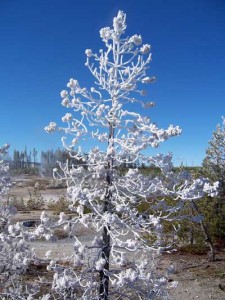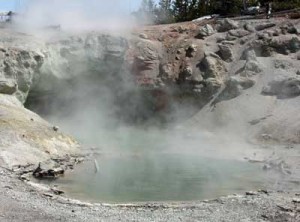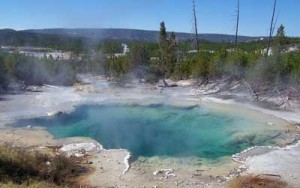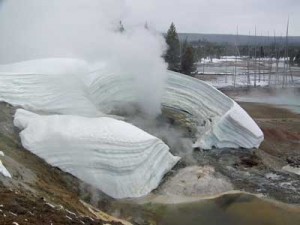Norris Geyser Basin
Posted by Jim Steele on April 22nd, 2009 filed in Yellowstone National ParkIf you asked me to pick my favorite thermal area in Yellowstone National Park, my brain would probably short circuit. The Upper Geyser Basin with Old Faithful is a natural candidate. Shoshone Geyser Basin, buried deep in the backcountry, is fun to explore. And the Mud Volcano area is truly intriguing. Another that belongs on the list is the Norris Geyser Basin, which just might be the most dynamic.

Norris is the home of the famous Steamboat Geyser, which is the world’s tallest but erupts infrequently and unpredictably. Some of the scenes, such as Pork Chop Geyser and the silica-filled dead forests, tell a story. You’ll see an incredible range of colors. And the setting, where you’ll feel like you’re surrounded by a ring of mountains, is gorgeous.
View Larger Map
But first, a caveat. Most of the adventures I have written about are true hikes, where you venture miles back into the mountains and, presumably, escape civilization. Norris offers a stroll through a developed geyser basin where you’re never too far from a boardwalk. Don’t expect a lot of solitude, and don’t count on seeing anything that has never been seen.
That said, this is a very interesting geyser basin to explore. Norris is located near the center of the park at a junction, so if you’re exploring Yellowstone, odds are you’ll be in the neighborhood. There are more interpretive signs than in most of Yellowstone’s thermal areas, so you’ll learn something while you’re there. And Norris is generally accessible throughout the entire summer season, from mid April through early November, although you might encounter some snow on the boardwalks in the fringe seasons.

The Norris junction is located 21 miles south of the Mammoth Hot Springs area, 12 miles west of Canyon Village, and 14 miles northeast of Madison Junction. From the junction, head west for about a quarter mile to a large parking lot. Norris has a Yellowstone Association bookstore, small museum, outhouses and a pay phone, but no other services.
There are two main loops at Norris. The Back Basin Loop is about 1.5 miles and includes Steamboat Geyser. The Porcelain Basin Loop is about 0.5 miles and includes some fantastic views of the surrounding mountains. Both loops start at the Norris Museum. A one-mile trail to the Norris Campground and Museum of the National Park Ranger starts from the Porcelain Basin Loop trail.

The trails are well marked and there are maps at many of the junctions so it’s easy to find what you’re interested in. A “Norris Geyser Basin Trail Guide” published by the National Park Service is available for 50 cents at the trailhead. This brochure is very informative and I recommend buying one.
Here are a few highlights to watch for:
Steamboat Geyser: Steamboat has frequent minor eruptions, but the Holy Grail is a full eruption, which was last seen in 2005. Steamboat, located just a few minutes from the Norris Museum, is on the Back Basin Loop. It is the world’s tallest geyser, erupting to heights of 300 feet. It was last seen by a couple that was camping illegally in the Norris parking lot and heard the tremendous rumbling of the geyser. You probably won’t see a major eruption of Steamboat, but it does have frequent minor eruptions.

Pork Chop Geyser: Pork Chop is always good for a chuckle because of the name. But the geyser also has an interesting story. It formed when the vent of a formerly tame hot spring wasn’t able to regulate the pressure coming from below, resulting in an explosion that left several large chunks of the geyser strewn around the vent. This is one of the settings where Norris really seems to tell a story – it doesn’t take much imagination to see nature at work here. It’s also interesting to note that the trail between nearby Yellow Funnel Spring and Pearl Geyser was rerouted a few years ago when the ground temperatures reached the boiling point.

Green Dragon Spring: This feature, also on the Back Basin Loop, reminds me of Dragon’s Mouth Spring in the Mud Volcano area. Steam is constantly being released from a pool that partially fills a cave cut out of the side of a hill. It’s a really interesting setting.

Other highlights on the Back Basin Loop: Emerald Spring, which is a gorgeous blue color. Cistern Spring, which also has a vibrant color. The dead forests, killed when the waters of the geyser basin changed course, hardening their trunks with silica.

Porcelain Basin Loop: There is an interesting contrast between the Back Basin Loop and the Porcelain Basin Loop. While the Back Basin Loop is partially forested, the Porcelain Basin Loop is generally open. The Black Growler Steam Vent is one of the most interesting features, shooting an often-tall column of steam that is visible from much of the basin.

The colors: You’ll see a great diversity of colors along these trails. Some of the hot pools will be a gorgeous blue. Some of the runoff channels will be covered with deep green mats. Plenty of the sulfur-rich features will be yellow. The forests could be green, or – in a few cases – a spooky white where they have been killed by overheated soil or ever-moving water channels. And depending on the season, the surrounding mountains could be snow-capped.
These are just a few of the dozens of interesting thermal features in the Norris Geyser Basin. These are the features that I thought were interesting – you could be intrigued by a completely different set of features.
One more suggestion: the Park Service often offers interpretive tours of Norris. These are interesting and will give you an interesting perspective on the geyser basin.
Â
